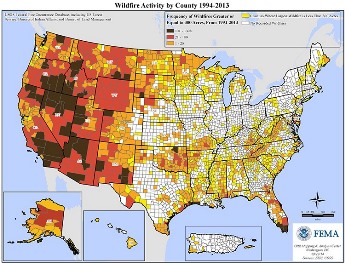
Wildfires
Wildfires have steadily become a more pronounced threat across the United States. Wildfires occur when a combination of weather conditions and fuel loads come together to create favorable conditions for both ignition and spread. Wildfires are most prevalent in the Plain States during the late winter and early spring. In the West, wildfire season generally peaks during the mid to late summer. However, wildfires can occur year-round.
Wildfires pose a particular risk for rural communities because of the vast amount of resources needed to combat them. A large-scale response to a wildfire may last several days to weeks and be made up of a combination of local, state, and federal resources. It is not uncommon to see dozens of local jurisdictions responding collectively to a fire.
Wildfires can severely impact rural communities in a number of ways. Fires can significantly damage infrastructure - homes, barns, sheds, fencing - as well as farm equipment, vehicles, and structural damage to essential services such as electricity and water. If evacuations are necessary, communities will need a plan for short-term or long-term sheltering as well as for dealing with supplies both requested and donated. Livestock or pets that are in the path of a fire may be killed or injured from the fire itself or from smoke inhalation. Even if livestock are not physically injured, the loss of feed, either from burnt pasture land or consumed hay, may make continued livestock production difficult.
Understanding and identifying your risk to wildfires is the first step in potentially limiting their impact on your home, farm, or livestock. The following factsheets provide suggestions to reduce your risk during wildfires, take action during wildfire situations, and recover after a wildfire has impacted your family.
Wildfire Preparedness Factsheets
|
• Wildfires and Your Family [PDF]
• More Family Resources |
|
|
• Wildfires and Your Home [PDF]
• More Home Resources |
|
| • Wildfires and Your Livestock [PDF] • More Livestock Resources |
|
|
• Wildfires and Your Farm [PDF] • More Farm Resources |
Know the Terminology
Fire Weather Watch: issued when the potential for severe fire weather exists in the near future – usually in 12 and 24 hours – but sometimes days in advance.
Red Flag Warning: issued to indicate the imminent danger of severe fire weather with a relatively high probability of occurrence.
Determine the risk of wildfire in your area.
Map showing active weather alerts and forcast maps.
National Weather Service
Learn about Wildfires and Their Impact
Website describing the National Fire Danger Rating System.
National Park Service
Website with information on preparedness, response, and recovery from wildfires.
National Weather Service
Website with resources for preparing before a wildfire, actions during a wildfire, and how to recover after a wildfire.
Centers for Disease Control and Prevention






